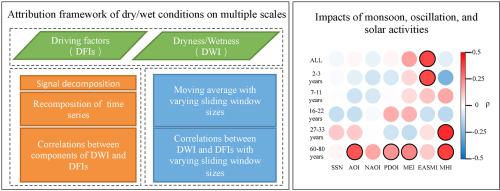Environmental Modelling & Software ( IF 4.8 ) Pub Date : 2021-06-22 , DOI: 10.1016/j.envsoft.2021.105116 Xinyu Chen , Quan Quan , Ke Zhang , Jiahua Wei

|
The Weihe River Basin (WRB) in a monsoon transition zone of East Asia interacts with multiple weather systems and is susceptible to floods and droughts. We developed a framework based on the Empirical Orthogonal Function analysis, Complete Ensemble Empirical Mode Decomposition with Adaptive Noise analysis, and moving-average based Spearman rank correlation to identify the spatial patterns of the dry/wet conditions from 1470 to 2016, decompose the dry/wet index into the leading components with a period between 2 and 3 years and 100+ years, and discover their driving forces on multiple time scales. Results show that WRB can be divided into four distinguishable hydroclimatic subregions located in the southeast, west, central, and north. The East Asian summer monsoon and South Asian summer monsoon impact this region mainly on the inter-annual and inter-decadal scales, while the impacts of ENSO, PDO, AO, and NAO are dominant on the multi-decadal and centennial scales.
中文翻译:

近547年东亚典型季风过渡带渭河流域干湿条件时空特征及归因
位于东亚季风过渡带的渭河流域(WRB)与多种天气系统相互作用,易受洪水和干旱的影响。我们开发了一个基于经验正交函数分析、具有自适应噪声分析的完整集合经验模式分解和基于移动平均的 Spearman 秩相关的框架,以识别 1470 年至 2016 年干/湿条件的空间模式,分解干/湿指数进入2-3年和100+年周期的主导成分,并在多个时间尺度上发现它们的驱动力。结果表明,WRB可划分为位于东南、西部、中部和北部的四个可区分的水文气候亚区。











































 京公网安备 11010802027423号
京公网安备 11010802027423号